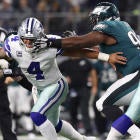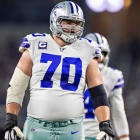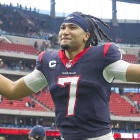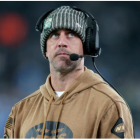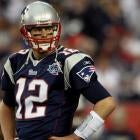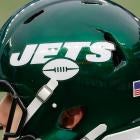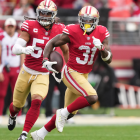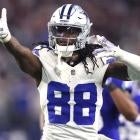It seems safe to say that both the Dallas Cowboys and Philadelphia Eagles are disappointed with the way things have gone six weeks into their respective seasons.
Dallas got off to a scorching-hot 3-0 start and looked ready to roll to an NFC East crown, only to see things come to a screeching halt with three consecutive losses. The first two of those defeats seemed excusable and explainable, but last week's loss to the Jets seemed like something else. Philadelphia has seen its defense take a massive step backward and it's prevented them from getting on any kind of roll. After rebounding from a 1-2 start with two straight wins, the Eagles were blown off the field by the Vikings last week.
Both teams have extensive injury issues to deal with on both sides of the ball, and neither looks like the best version of itself at this moment. But even when you're banged up, you've still got to play the games on the schedule, and you've still got to find a way to come out of them with wins.
These old NFC East rivals square off on Sunday night, and it'll be fascinating to see how the injuries, the deficiencies, and the tendencies combine to reveal a winner. Let's break things down.
When the Cowboys have the ball
Let's talk about what's happened to the Dallas offense, which looked like it had been shot out of a rocket-ship three weeks into the season, but has come crashing back down to earth in the three weeks since. During the offseason, we ran a series of posts highlighting what NFL contenders needed to do to get themselves to the Super Bowl this season. I wrote the story on the Cowboys, and the No. 1 thing I said they needed to do was, "Empower Kellen Moore to make deep, systemic changes to the offense."
Three weeks into the year, it could not have possibly been going better. As I wrote in our Cowboys-Saints preview prior to Week 4:
- More play-action passing. Despite play-action throws being more efficient than straight dropbacks leaguewide and for Dak Prescott in particular, only 22.9 percent of his throws came after a run fake during the first three years of his career, per Pro Football Focus. This season, he's faked a hand-off on 39.4 percent of his throws and has a 137.4 passer rating on those plays.
- More deep passing. Prescott was arguably the single most effective deep passer in the league during his first three years, recording a 115.9 passer rating on throws that traveled 20-plus yards in the air, per PFF. But those throws accounted for only 9.4 percent of his total. This year, Dak has thrown deep 17.0 percent of the time, with a 114.6 rating on those plays.
- More RPO plays. Prescott threw a total of 11 passes on RPO plays last season, per Sports Info Solutions. Through the first three weeks of this season, he has a league-high 11 completions on RPO plays. (He's 11-11 for 100 yards.)
- Wider throwing lanes and attacking past the sticks. Last year, 17.7 percent of Prescott's throws went into tight coverage. This year that figure is down to 16.0 percent. Last year his average throw was 1.5 yards short of the line to gain. This year it has gone 0.8 yards past the line to gain.
- More pre-snap motion. Last year's Cowboys utilized pre-snap motion on only 31 percent of their offensive plays, per Sports Info Solutions, a rate that both ranked 24th out of the league's 32 teams and was well below the league average of 36.6 percent. This year they are utilizing motion (or formation shifts) on damn near every play.
But look at how things have changed since then.
Cowboys | Week 1-3 | Week 4-6 |
Total Plays | 194 | 197 |
Yds/Play | 7.4 | 6.2 |
Pass | 97 | 117 |
Yds/Pass | 9.8 | 8.3 |
RB Run | 85 | 65 |
Yds/RB Run | 5.2 | 3.6 |
Sack | 3 | 6 |
Pressure % | 21.2% | 43.8% |
Play Action % | 39.4% | 17.2% |
Deep Pass % | 17.0% | 12.8% |
< 2.5 sec % | 45.5% | 42.5% |
Tight Window % | 15.5% | 17.9% |
Shift/Motion % | 61.6% | 51.3% |
Points/Game | 32.3 | 18.7 |
DVOA (after game) | 54.15% | 28.49% |
Given how aggressively the Cowboys pursued optimal strategies in the first three weeks of the season and how completely they appear to have regressed since then, it's fair to wonder what changed. Well, let's ask a few former Cowboys.
"I see a lot of Jason Garrett's footprints in this offense."
— Shan Shariff (@1053SS) October 13, 2019
-@tonyromo
That was low key cold blooded lol https://t.co/CRnxYB15qz
— Dez Bryant (@DezBryant) October 14, 2019
Hey @realjerryjones!! Still think Jason Garrett is the answer?! For a decade, A DECADE NOW, it's the same old song and dance! I knew they were going to @JasonWitten on the 3rd down prior to TD and knew they were going to him on the 2-pt conversion. Not too late 2 bring me back 😜
— Terrell Owens (@terrellowens) October 13, 2019
Nothing to do with the players.. whenever training camp start for the cowboys it’s training camp until the season is over.. a lot of pointless meetings not enough time for the players to recover from injuries preparing for the next game... https://t.co/ImP2Pew3k2
— Dez Bryant (@DezBryant) October 14, 2019
And that all tracks. The regression of the Dallas offense to what it has been over the past several seasons seems exactly like Garrett asserting his control. But that's what has happened. The more pertinent question is what will happen and what should happen, and that's what we'll concern ourselves with here.
Based on what has happened so far this season, the Cowboys should be able to find success throwing the ball against this Philadelphia secondary. Pretty much everyone has so far this year, including last week, when Kirk Cousins practically lit the field on fire. The Eagles have used five cornerbacks for at least 30 snaps in coverage this season: Rasul Douglas, Avonte Maddox, Sidney Jones, Ronald Darby, and Craig James. All five of them have allowed a passer rating of at least 104.4 on throws in their direction, per Pro Football Focus, with Douglas, Darby, and James allowing ratings of 110 or higher. The issues have extended to safeties Andrew Sendejo and Malcolm Jenkins, who have each allowed passer ratings better than 108 on throws to their coverage area.
If Amari Cooper is healthy and able to play (he has not practiced this week but said on Thursday he was preparing as if he would be out there this weekend), he and Michael Gallup are going to absolutely eat against these guys. They torched the Packers through the air two weeks ago, and their numbers likely should have been even better in that game, as Cooper dropped one sure touchdown pass and tripped over his own feet on another. Gallup has had some drop issues, but he seems to be open on every snap and is averaging 16.8 yards per catch, and 96.8 yards per game.
The only question with the Dallas passing game will be whether the offensive line can hold up against Philadelphia's pass rush. With Tyron Smith and La'el Collins out last week, the Cowboys had a pair of turnstiles (Cameron Fleming, Brandon Knight) bookending the line, and that's not tenable against the likes of Derek Barnett and Brandon Graham. Smith and Collins got in limited work on Thursday; and if they're on the field to help Zack Martin, Travis Frederick, and Connor Williams, the Cowboys should go back to giving Dak Prescott plenty of time to throw, and that'll undoubtedly lead to success against the flammable Philly back end.
Of course, the natural extension of that fact should be that the Cowboys get back to throwing the ball (and specifically using play-action) early and often, but it's anybody's guess as to whether Garrett and Moore will actually do so. They seem pretty intent on getting Ezekiel Elliott the ball as often as possible -- thus justifying in their minds the exorbitant contract to which he was signed -- even though that's pretty clearly not the best way to win football games in 2019. Throw to win, and then win to run. That's how it goes. The sooner the Cowboys learn, the better off they'll be.
When the Eagles have the ball
I feel like it should be noted that Carson Wentz is balling this season.
Despite spending much of the year working without DeSean Jackson and/or Alshon Jeffery, despite injuries along the offensive line, and despite drop issues so bad that a Philadelphia man who saved children from a burning building couldn't help but throw some shade in wideout Nelson Agholor's direction, Wentz looks really damn good. (Eagles pass-catchers have dropped 17 of Wentz's 214 pass attempts. That's the most drops any quarterback in the league has had to weather -- one ahead of Prescott.) He's probably two drops away from having the Eagles at 4-2 or 5-1 instead of 3-3, and if that were the case, his start would be getting a bunch more attention.
The Dallas pass defense has not been quite as disastrous as that of the Eagles, but it has certainly left much to be desired and has to be considered a massive disappointment after showing great improvement last season. Cornerback Byron Jones has been good but not great. Chidobe Awuzie, playing opposite him, has been horrid. Anthony Brown has been fine working out of the slot. It doesn't help that the Cowboys are banged up in the secondary, with Jones and Brown each taking DNPs at Wednesday's practice.
But the real culprits have been linebackers Leighton Vander Esch and Jaylon Smith, who appear to have badly regressed since last season. Tight ends and running backs are smoking these guys in coverage, especially after the catch. (They've each allowed more than 136 yards after the catch, making them two of just 27 linebackers or safeties who have done so -- and that's out of 241 such players who have seen the field.) That sets up well for the Eagles, whose best pass-catcher is Zach Ertz and who appears to have found a way to utilize rookie running back Miles Sanders in the passing game as well.
Ertz has yet to have a blow-up game and has not surpassed 72 receiving yards in any contest, but he has Wentz's trust, and he has torched Dallas on occasion in the past. Sanders, meanwhile, has caught seven of eight passes for 135 yards and a score over the past two weeks despite playing only 47 total snaps.
Making matters worse for the Dallas defense is that outside of Robert Quinn, they have largely struggled to generate pressure on opposing quarterbacks. Demarcus Lawrence averaged four pressures per game last year, per PFF, but is down to three per game this year. Randy Gregory is still not back from suspension. Of the Cowboys' interior linemen, only Maliek Collins has gotten anything resembling a push of the pocket. Christian Covington has played 124 snaps and has just one hit and seven hurries. Tyrone Crawford is now out for the year, and he didn't do much of anything when he was healthy anyway. Antwaun Woods has been injured for most of the season. Second-round pick Trysten Hill has been invisible.
The Eagles' offensive line has yielded the 12th-lowest pressure rate in the NFL so far this season, per Football Outsiders, and unless Lawrence, Quinn, Collins, and/or Dorance Armstrong suddenly begins dominating, it seems unlikely they'll be bothering Wentz all that much. That'll be easier for them to do if Jason Peters sits out for this game (he has yet to practice this week), but it's not as though Halapoulivaati Vaitai is a turnstile. He's a solid replacement.
Dallas has had issues stopping the run as well, though that's less of an issue against an Eagles team that has had some struggles of its own on the ground. Philly has increasingly been turning to Jordan Howard as the lead back, but in five games with 8-plus carries, he's failed to crack 50 yards on the ground three times. He is a total non-threat in the passing game so opponents can completely disregard that aspect of the offense when he's on the field, and the Cowboys should be free to do so as well. The Eagles would do well to get him a screen pass off play-action early in the game in order to keep them honest, which could help open things up for Ertz over the middle and Alshon Jeffery on the perimeter.
Prediction: Cowboys 33, Eagles 30









